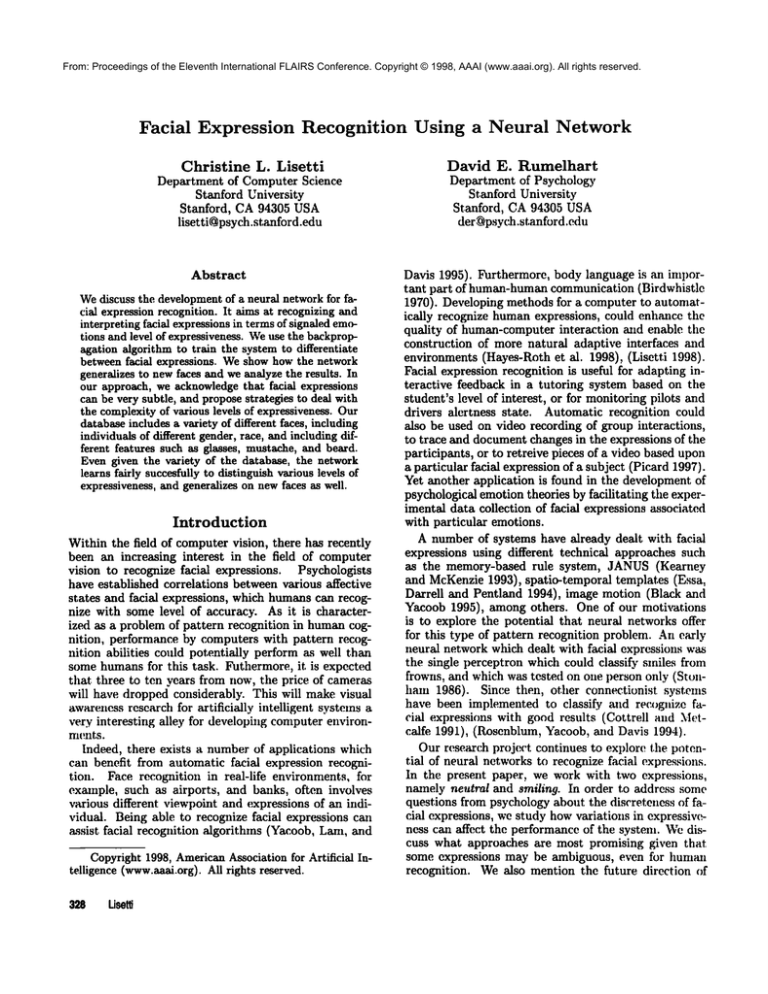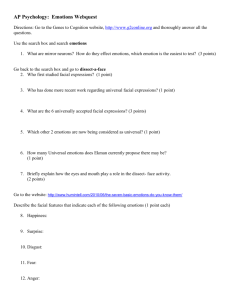
From: Proceedings of the Eleventh International FLAIRS Conference. Copyright © 1998, AAAI (www.aaai.org). All rights reserved.
Facial
Expression
Recognition
Using
a Neural
Network
Christine L. Lisetti
David E. Rumelhart
Department of Computer Science
Stanford University
Stanford, CA 94305 USA
lisetti@psych.stanford.edu
Department of Psychology
Stanford University
Stanford, CA 94305 USA
der@psych.stanford.edu
Abstract
Wediscuss the developmentof a neural networkfor facial expression recognition. It aims at recognizing and
interpreting facial expressionsin terms of signaled emotions and level of expressiveness. Weuse the backpropagation algorithm to train the systemto differentiate
between facial expressions. Weshow howthe network
generalizes to newfaces and we analyze the results. In
our approach, we acknowledgethat facial expressions
can be very subtle, and propose strategies to deal with
the complexityof various levels of expressiveness. Our
databaseincludes a variety of different faces, including
individuals of different gender, race, and including different features such as glasses, mustache, and beard.
Even given the variety of the database, the network
learns fairly succesfuily to distinguish various levels of
expressiveness, and generalizes on newfaces as ~ell.
Introduction
Within the field of computer vision, there has recently
been an increasing interest in the field of computer
vision to recognize facial expressions. Psychologists
have established correlations between various affective
states and facial expressions, which humanscan recognize with some level of accuracy. As it is characterized as a problem of pattern recognition in humancognition, performance by computers with pattern recognition abilities could potentially perform as well than
some humans for this task. Futhermore, it is expected
that three to ten years from now, the price of cameras
will have dropped considerably. This will make visual
awareness research for artificially intelligent systems a
very interesting alley for developing computer environnlents.
Indeed, there exists a number of applications which
can benefit from automatic facial expression recognition. Face recognition in real-life environments, for
example, such as airports, and banks, often involves
various different viewpoint and expressions of an individual. Being able to recognize facial expressions can
assist facial recognition algorithms (Yacoob, Lanl, arid
Copyright1998, AmericanAssociation for Artificial Intelligence (www.aaal.org).All rights reserved.
Davis 1995). Furthermore, body language is an important part of human-humancommunication (Birdwhistle
1970). Developing methods for a computer to automatically recognize humanexpressions, could enhance the
quality of human-computer interaction and enable the
construction of more natural adaptive interfaces mid
environments (Hayes-Roth et al. 1998), (Lisetti 1998).
Facial expression recognition is useful for ’adapting interactive feedback in a tutoring system based on the
student’s level of interest, or for monitoring pilots and
drivers alertness state. Automatic recognition could
also be used on video recording of group interactions,
to trace and documentchanges in the expressions of the
participants, or to retreive pieces of a video based upon
a particular facial expression of a subject (Picard 1997).
Yet another application is found in the development of
psychological emotiontheories by facilitating the experimental data collection of facial expressions associated
with particular emotions.
A number of systems have already dealt with facial
expressions using different technical approaches such
as the memory-based rule system, JANUS(Kearney
and McKenzie1993), spatio-temporal templates (Essa,
Darrell and Pentland 1994), image motion (Black and
Yacoob 1995), among others. One of our motivations
is to explore the potential that neural networks offer
for this type of pattern recognition problem. An early
neural network which dealt with facial expressions was
the single perceptron which could classiC" snfiles from
frowns, and which was tested on one person only (Stunhain 1986). Since then, other connectionist systems
have been implemented to classify mid recognize facial expressions with good results (Cottrell and Metcalfe 1991), (Roscnblum, Yacoob, and Davis 1994}.
Our researc~ project continues to explore the potential of neural networks to recognize facial expressions.
In the present paper, we work with two expressions,
nmnely neutral and smiling. In order to addrcss some
questions from psychology about the discreteness of facial expressions, we study howvariations in expressiw:ness can affect the performance of the system. Wediscuss what approaches are most promising given that
some expressions may be ambiguous, even for human
recognition. Wealso mention the future direction of
ourongoing
project.
Facial Expressions as Emotional and
Communicative Signals
Facial expressions can be viewed as communicative signals (Chovil 1991), associated with syntactic displays,
speaker displays, or with listener commentdisplays in a
conversation. This approach has been used to improve
human-computer interaction with speech dialog (Nagao
and Takeuchi 1994).
Facial expressions can also be considered as expressions of emotion (Ekman and Friesen 1975), raising
ongoing debates about their discretness and universality. One of the most documentedresearch effort led by
Ekmanhas permitted to identified six basic universal
emotions: fear, anger, surprise, disgust, happiness, and
sadness(EkmanandFriesen1975).OtherslikeRussel
preferto thinkthatfacialexpressions
andlabelsare
probably
associated,
butthattheassociation
mayvary
withculture
(Russel
1994).
Whetheror notthereexistuniversal
facialexpressions,
Wierzbicka
points
at thedifficulty
to talkabout
emotions,
and warnsthatwhatwe referto as basic
emotions with labels such as "anger", may have concepts which may very well be culturally determined
(Wierzbicka 1992). Studying these concerns is beyond
the scope of this paper, and need to be addressed in further details when dealing with particular applications.
Relevant expressions and their interpretations may indeed vary depending upon the chosen type of application (Lisetti, 1998).
In this present paper, however, we address some of
the issues above by focusing on getting a neural network
to be able to recognize differences in levels of expressiveness from two emotions: happy and neutral.
the FERETdata base of face images which inchlded
smiling faces and neutral faces. 2 The FERETdatabase
includes pictures of faces with various poses (such as full
face, profile, and half profiles) for each person. These
pictures are useful to build face recognition algorithms
in terms of person identification from different angles.
Since we are presently exclusively interested in facial
expressions, however, we built a sub-set of the FERET
data base to include only two different poses per person: namely one full face with a neutral expression,
and the other full face with a smile. Not every one of
the pictures had the same degree of neutrality, or the
same degree of "smilingness". Wehave designed various approaches to test this scalability amongimages.
As stated above, one of the advantages of the FERET
images was that all the images were consistent enough
in terms of size and position.
Interpreting facial expressions of an individual in
terms of signaled emotions requires us to work with
minute changes of some features with highly expressional value. Someexamples of those are found in the
mouth such as the orientation of the lips (up or down),
in the eyes such as the openess of the eyes, etc.
There are three areas of the face capable of independent muscular movement: the brow/forehead; the
eyes/lids and root of the nose; and the lower face including the cheeks, mouth, most of the nose and the
chin (Ekman 1975). Furthermore, not every expression
is shown in the same area of the face. For example
surprise is often shown in the upper part of the face
with wrinkles in the forehead and raised eyebrow’s, while
smile is mostly shownin the lower face.
By contrast with non-connectionist approaches which
usually use geometrical face codings, connectionist approaches have typically used image-based representation of faces in the form of 2D pixel intensity array. While this model has the advantage of preserving
the relationship between features and texture, it has a
very high sensitivity to variations in lighting conditions,
head orientation, and size of the picture (Valentin et al.
1994). These problems typically justify a large amount
of work in preprocessing the images. Normalization for
size and position is necessary and can bc performed automatically with algorithms for locating the face in the
image and rescaling it (Turk and Pentland 1991).
our particular data set, there was no need for rescaling,
as all the images were consistent with each other along
that dimension.
The Network Architecture
Our network is designed to deal separately with the
three areas of the face capable of independent muscle
movementmentioned above. It, is illustrated
in figure 1. Each portions of the face is pre-processed by
cropping the initial full-face/background images (manually at this stage) to smaller sizes, and normalized in
terms of intensity by histogram.
The network includes one layer of input units, one
layer of hidden units and one layer of output units. The
input units are 2D pixel intensity arrays of the cropped
images. The output units express the value of expressiveness of a particular expression ranging from 1 to 8,
or from 1 to 6, depending upon the experiment. The
hidden layer is connected to each portion of the face
and to each output unit in order to simulate "holistic"
face perception. Alternatively, the connections can bc
loosen, to model more local pattern recognition algorithm.
Finally, because, in the future, we also want to bc
able to refer to the recognized expression with a label
such as "happy", or "angry", we provide an ordered
The Data Base of Images
Weused images from a variety of sources. The results
described below- have been derived mostly from using
2Portions of this research in this paper use the FERET
database of facial images collected under the ARPA/ARL
FERETprogram.
Facial Expression Interpretation
Backpropagation
Using a
Neural Networks
329
input mask of binary values for each of tile emotions
to lie recognized. These can be the 6 basic emotions,
l)ius neutral: bit 1: fear, bit 2: angry, bit 3: surprise,
bit 4: disgnst, bit 5: happiness, bit 6: sadness, bit 7
neutral. These binary output values are to be turned
on to "1’ if the expression is identified, while the others
remain se, t to ’0’. An example of output will be in
addition to the level of expressiveness from the regular
output units, the left set of output units will point to
the label "3" by turning on the third bit of the maskas
Figure 2: Full Face Neutral
in [0.0,1,0,0,0,0].
’v~’E
/ neO"v~ar~D
~..,,,.,:.,.~,,>
I eV~.l~l.~Ot’Tltm(~V.~l~-I
¯ - [
’
Ime
, , ,,
E%PRFS$iD,’~Fa’(’E
BRDWI
l I
EYES.’
MOL’11]
Figure 1: Network Design
In order to test each portion of the network, however, we built subnetworks each dealing with different
portions of the face. Wediscuss here the results for the
full face subnetwork, and the mouth/part-of-nose/partof-chin subnetwork. Wedesigned different strategies to
test which approach would be better fit to recognize fa(:i’M expressions in terms of degree of expressiveness: in
this case, the degree of smilingness.
Wereduced our images to 68X68pixel images, for our
fltll-face
experiments, and we reduced them to 74X73
for our lower fa(:e experiments.
Full Face Network
Test 1: Graded Answers In our initial
stage, we
l)reprocessed the images marmally, cropped the outer
edges of the face leaving the flfll face as shownin figures 2 and 3. Weperformed histogram equalization for
normalizing intensity across the different images.
Data: The network had 40 hidden units, one input
unit per pixel, and one single output unit. Wetrained
tim network on 40 input images. We included images
of 20 different persons, two images per person. Weselected randomly 30 images in our training set arid 10
330 Lisetti
Figure 3: Full Face Smiling
IliddelL~.
images in our testing set for generalization. Target valties ranged from 1 to 8 (similarly to psychological tests
used in emotion research), to indicate the level of expressiveness of the image.
Results: The results of the training shownin figure 4
indicate that the network learned accurately. The plots
compare: (1) the given target expressed in terms
the degree of expressiveness of a particular image (’x’)
with (2) the actual output of the network generalization and training (’o’). Generalization was then tested
on new faces of persons that the network had ne~r
"seen" before . The generalization results are shown
in figure 5, indicating that the network did not generalize completly, as can be observed by the differences
between targets and outputs.
Lower
Face
Network
Happiness and satisfaction are typically shown in the
third area of the face capable of independent movement.
It includes the mouth, most of the nose and the chin
(Ekman 1975). Wetherefore isolated this area of the
face and generated cropped images including the lower
face only. The input images were 74x73 pixel images.
Wedesigned two procedures to test howwell the network could generalize on new images that it haxt not
been trained with: (1) testing whether the network
could generalize if it had been trained on the person
with one expression but not on the other, (2) testing
whether the network could generalize on people which
it had never been exposed to (i.e. with neither expression).
Test 2: With prior
exposure
to the person
Data: In this case, we selected intermittently neutrM
faces, arid smiling faces. That is, instead of training
the network on both expressions for each individual,
we trained the network on each individual, soinetimes
including both expressions but sometimes witholding
either one of the two expressions. In that manner, we
Figure 6: Full Face Processing
Figure 4:I~i11
FaceProcessing
TIM1"GmllTmzWlon
.,., ....... , ........ . ........ , ....
¯ Lqrget
o oumm
o
o
Figure 7: Lower Face Processing
o
i
IO
Figure5: FullFaceProcessing
couldtesthowwellit generalized,
without
havingbeen
exposed
to bothexpressions
of thesamepersonduring
the training stage.
Results:
Theresults
areshownin figures
7 and8.
Onceagainthe training
wasverysuccessful
as the
networkapproximated
itsoutputto be verycloseto
the valueswe had givenit as targets.The network
generalized
veryaccurately
foreachof thetestcasesas
canbe observed
fromfigure8. We alsowantedto know
if thenetwork
couldgeneralize
on smiles
of people
that
it hadneverbeenexposed
to.
Test 3: Without prior exposure to the person
Data:Thistime,we trainedthe networkon 116 input
imagesof size(74X73).
Results:
We included
imagesof 58 different
persons,
two imagesperperson.We selected
94 imagesfor our
training
setand22 imagesforourtesting
setforgeneralization.
Plotsin figures
9 and10 compare:
(1)the
giventarget
expressed
in termsof thedegree
of expressiveness
of a particular
image(’x’)with(2)theactual
output
of thenetwork
generalization
mzdtraining
(’o’).
As canbe observed
fromthegraphs,theoutputs
match
closely
thegiventargets.
A summary
of theerroraveragesforeachtestisgivenbelowinabsolute
values
(see
table1).Itliststhedifference
between
target
values
and
output values, averaged over the number of images.
Conclusion
Our results indicate that zooming in particular areas
of the face for expression detection offers better results
than processing the full face as a whole. Our next approach will be to isolate each area of the face, and combine their inputs into a single network to increase precision of our recognition algorithm as described earlier.
One extension of the facial expression system will be the
integration of the recognition scheme with a real-time
tracker. This coupling is planned to enable the system
to perform real-time recognition of facial expressions.
Acknowledgement
Wewould like to acknowledgeIntel Corporation for partial funding for this research.
References
Birdwhistle.
1970. Kinesics and Context: Essays
on Body Motion and Communication. University of
Pennsylvania Press.
Black, & Yacoob, Y. 1995. Recognizing Faces Showing
Expressions. Proceedings of the International Workshop on Automatic Face and Gesture Recognition,
IEEE Press.
Black, M., and Yacoob, Y. 1995. Tracking and Recognizing Rigid and Non-Rigid Facial Motions using Local Parametric Models of Image Motion. Proceedings
Int’l Conference Computer Vision ICCV’95, 374-381.
Chovil, N. 1991. Discourse-Oriented Facial Displays
in Conversation. Research on Language and Social
Interaction 25:163-194.
Cottrell, G. and Metcalfe 1991. EMPATH:
Face, Emotion, and Gender Recognition using Holons. AdNeuralNetworks331
Figure 8: Lowcr Face Processing
s:
ss.
m
¯ i.s,*
Table 1: Error Averages (absolute values)
4s,
’!
--P
& ~, = .......
~ -"
.o
~
.,
.o
Figure 9: LowerFace without Prior Exposure
vances in Neural Information Processing, Morgan
KaufmannPublishers.
Ekman, P., and Friesen, W. V. 1975 Unmasking the
Face: A Guide to Recognizing Emotions from Facial
Expressions, EnglewoodCliffs, NewJersey: Prentice
Hall, Inc.
Essa, I.; Darrell, T.; and Pentland, A. 1994 Tracking
Facial Motion, Proceedings of IEEE Workshopon
Nonrigid and Articulate Motion. IEEE Computer
Society Press.
Hayes-Rx)th,B.; Ball, G.; Lisetti, C.; Picard, R.; and
Stern, A. 1998. Panel on Affect and Emotion in the
User Interface. In Proceedings of the 1998 International Conferenceon Intelligent User Interfaces, 9194. New York, NY: ACMPress.
Kem’ney, G. D. 1993. Machine Interpretation of Emotion: Design of a Memory-BasedExpert System for
hlterpreting Facial Expressions in Termsof Signaled
Emotions. Cognitive Science 17, 589--622.
Lisetti, C. L. 1998. An Environment to Acknowledge
the Interface between Affect and Cognition. In Working Notes of the AAAISpring Symposiumon Intelligent Environment, AAAIPress.
Nagao, K., and Takeuchi, A. 1994. Speech Dialogue
with Facial Displays: Multimodal Human-Computer
Conversation. In Proceedings of the 32nd Annual
Meeting of the Association for Computational Linguistics.
332 Use~
Figure 10: Lower Face Without Prior Expt)sm’e
Test 1
Test. 2
Test 3
TRAINING
0.0496
0.0315
0.0428
GENERALIZATION
0.1072
0.0722
0.0756
Picard, R. 1997. A~ective Computing. Cambridge,
MA:MIT Press book.
rtosenblum, M.; Yacoob, Y.; and Davis, L. 1994¯ Human Emotion Recognition from Motion Using a Radial Basis Function Network Architecture.
IEEE
Workshop on Motion of Non-Rigid azld Articulated
Objects.
Rowley, H. A.; Baluja, S.; and Kanade, T. 1996. Neural Network-Based Face Detection. Proceedings of
IEEE Conference on Computer Vision and Pattern
Recognition, 6:285-319.
Russel, J. 1994. Is There Universal Recognition of Emotion From Facial Expression? A Review of CrossCultural Studies Psychological Bulletin 115(11102141.
Stonhanl, T. J. 1986. Practical face recognition and
verification with Wisard. In H. Ellis and M.A.Jeeves
(Eds.), Aspects of face processing. Lancaster, England: Martinus Nijhoff.
Turk, M., asld Pentland, A. 1991. Eigenfaces for Rerognition. Jom’nal of Cognitive Neuroscience. 3, 71-86.
Valentin, T.; Abdi, H.; O’Toole, A.; and Cottrell, G.
1994. Connectionist Models of Face Processing: A
Survey. PatteTm Recognition 27: 1290-1230.
Valentin, T. (Ed.) 1995 Cognitive and Computational
Aspects of Face Recognition: Explorations in Face
Space. NewYork, NY: Routledge.
Wierzbicka, A. 1992. Defining Emotion Concepts. Cognitive Science 16:539-581.
Yacoob, Y.; Lain, H.; and Davis, L. 1995. Recognizing Faces Showing Expressions. In Proceedings of
the International
Workshop on Automatic Face and
Gesture Recognition, IEEE Press.






